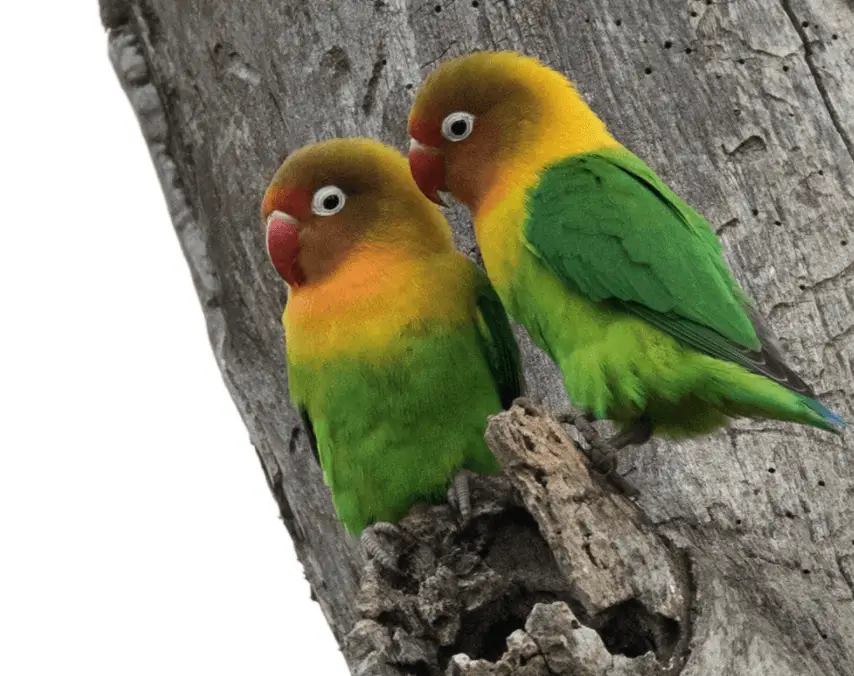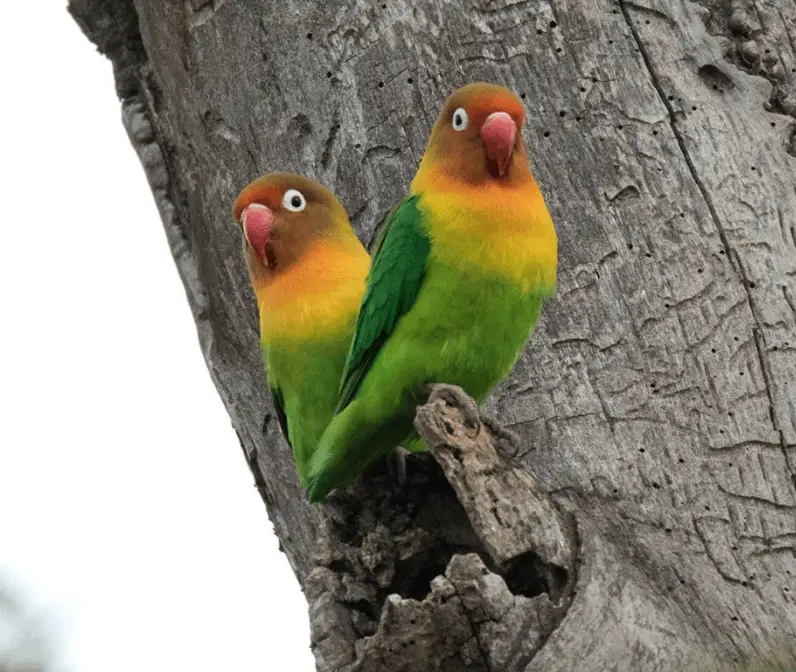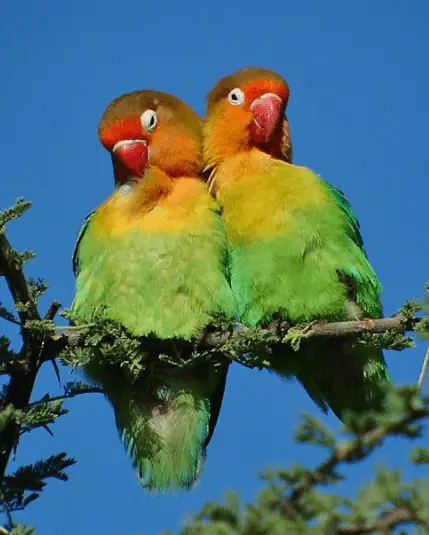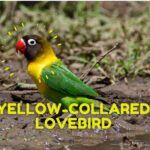Fischer’s Lovebird 15 cm; 42–58 g. Forehead and bill red, less intense on rest of head and shading on the nape, sides of neck and throat to yellowish pink, then green on lower breast and belly; back, wings and tail dark green; upper tail-coverts dark blue. Immature has a duller head.
Systematics History
Sometimes treated as conspecific with A. personatus, and also on occasion with A. lilianae and A. nigrigenis; perhaps best considered to form a species-group with all three. Monotypic.
Subspecies

Feral populations exist in coastal Tanzania and Kenya, including Dar es Salaam and Mombasa (also Nairobi), and in SE France, some mixed or hybridizing with A. personatus.
Fischer’s Lovebird Facts
Fischer’s Lovebirds as they are usually called, measure on average between 14 and 15 centimeters long. It is not a very large bird and its weight varies from 44 to 60 grams.
Fischer lovebird male or female
Fischer’s Lovebird Males and females have the same coloration, there is no sexual dimorphism, which means they do not have very visible differences. The big difference lies in the bones of the pelvis of the female which are always more distant from each other.
Its wings, chest, and back are basically an intense green color. The plumage of the neck is yellow in color, while the head is dark orange in color, the beak is bright red, and towards the top of the head, the color is olive green. As we can see, it is a multicolored bird.
It also has purple or in some cases blue feathers in the tail and its eyes are black. The color display of Agapornis fischeri does not stop there as color mutations have also been observed through interbreeding with other species of Agapornis. Like the one with the blue wings or the one with the greyish head.
Fischer’s Lovebird Mutations
- Fischer’s Lovebird blue
This is the oldest mutation. A specimen was found in the wild in the 1930s. It was donated to London Zoo. The green is replaced by blue, the beak is horn-colored, the collar becomes white, and the ring around the eye is still present. The top of the tail is purplish-blue. The blue is more or less clear verging on turquoise.
- Green Fischer lovebird
Green is the original color, so it’s not a mutation. the beak is red. We find an eye ring and a black head. The collar is yellow. The other shades of green, on the other hand, do correspond to mutations.
The color ranges from light green to almost yellow and all the way to dark green (thanks to the dark factor). With diluted greens, you can get diluted blues. We will then have 100% blue-green and diluted.
- Violets
True purples are rare, we obtain beautiful results by mating them with blues. Result: blue, cobalt, purplish-blue, and violet. Same thing with mauve we get cobalt, mauve, purple and purple mauve
- The elves
They are a bit apart. They appeared because of crossing with their cousins the Fischer. the most beautiful would have the head, the eyes as well as the red beak.
The rest body is all lemon yellow. The rump is white. By crossing it with a blue person we obtain the albino which is all white with red eyes.
- the half-sisters
It is not strictly speaking a mutation. Halfsiders are birds with two different sides. These individuals are remarkable because the limit between the colors is clear and is located just in the middle of the body on the line connecting the beak to the vent and going all around the body: these birds thus have two wings of different colors.
The genetic explanation for this phenomenon is simple: these are heterozygous birds carrying a recessive mutation that is in principle hidden but which in this case is expressed on half of the body.
- the quartersiders
This is a case close to half-sisters but these rare birds in which the recessive mutation which should remain hidden is expressed on a quarter of the body.
Custom considers these birds, like half-sisters, to be sterile, but this is not the case. Logically, however, this anomaly is not transmitted to the offspring.
Fischer’s Lovebird Colors
SOURCE: Bird Spy Australia
Distribution
Virtually confined to Tanzania S and E of L Victoria, including some islands off S shore; range centered on Serengeti. Records from S Kenya, Burundi, and Rwanda appear to refer to wild individuals irrupting in response to drought within normal range but could involve feral birds as well.
Fischer’s Lovebird Habitat
Wooded grasslands with Acacia, Commiphora, and Adansonia, at 1100–2200 m, and cultivated areas to the W of its range; found to be commonest in savanna dominated by Acacia tortillas, with other Acacia and Balanites aegyptiaca the principal associates, and a ground layer of grasses made up of Penisetum, Digitaria, Themeda and Eustachys.
Movement

Fischer’s Lovebird
Sedentary, although with local dry season movements, and irruptions in Jul–Aug some years into Rwanda and Burundi.
Fischer’s Lovebird Food
Essentially granivorous, including seeds of the grass Pennisetum medium and weed Achyranthes asper collected from seedheads or off the ground; also takes Acacia seeds directly from the tree or on the ground.
Sounds and Vocal Behavior
The commonest vocalization of Fischer’s Lovebird is a screechy “krreek” or a disyllabic “chi-reek!”. When perched, utters a wide variety of chirruping and screechy notes; also short rattles.
Large flocks maintain continuous twittering. No clear differences between A. personatus, A. Liliana, and A. nitrogenize.
Do Fischer lovebirds talk
SOURCE: Movie Walls
Fischer’s Lovebird Breeding

Jan–Apr, Jun–Jul. Most nests are 2–15 m up in dead trees or dead branches of living trees, commonly in old woodpecker or barbet holes in Acacia tortilis but also in natural cracks in Commiphora trothae branches, holes in Adansonia and frond-bases of Borassus palms; probably also sometimes in cliffs. In captivity : 3–8 eggs; incubation c. 23 days; nestling period 38 days.
Fischer’s Lovebird treatment
SOURCE: pet’s paradise veterinary clinic
Fischer’s Lovebird Lifespan
Like all other animal species, Fischer’s Lovebirds have an average lifespan. Their diet is quite balanced since they feed on seeds, cereals, and vegetables. In addition, they are kept off the ground and therefore less accessible to predators, which slightly increases their average lifespan.
Fischer’s Lovebirds can live up to 10 years, provided they have adequate living conditions. Especially when it comes to birds that are in captivity.
Fischer’s Lovebird Price
If you have decided to collect a Fischer’s Lovebird, you need to know that the investment you are going to make is not only when buying the bird. Indeed, you will also need a series of products for him to have an excellent quality of life.
Generally, the price of lovebirds varies depending on the pet store or lovebird breeder. But the average price is between 25$ and 50$. The country or even the region where you want to buy it can influence its price.
Conservation Status
Not globally threatened. CITES II. Currently considered near-threatened. A BirdLife “restricted-range” species. Locally common, fairly common, and widespread.





















